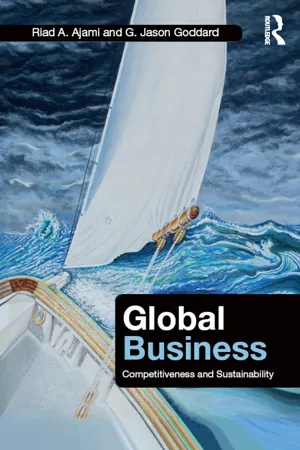Marketing
International Marketing
International marketing involves the process of promoting and selling products or services across national borders. It requires an understanding of different cultures, languages, and business practices to effectively reach and engage with diverse global markets. International marketing strategies often involve adapting products, pricing, distribution, and promotional efforts to meet the specific needs and preferences of consumers in different countries.
Written by Perlego with AI-assistance
Related key terms
1 of 5
11 Key excerpts on "International Marketing"
- eBook - PDF
- Joao Heitor De Avila Santos(Author)
- 2019(Publication Date)
- Society Publishing(Publisher)
The International Marketing manager’s task is to evaluate customers’ needs and purchases and inform production managers as to the types, quantities, and qualities of products most likely to be sold. Often hundreds of markets worldwide must be researched, analyzed, and targeted. Subsequently, a multitude of strategies for market segmentation, product introduction, pricing, and promotion must be coordinated to be able to avoid missed sales in one area and inventory buildups in another. Despite the increasing tendency toward globalization of the buying needs, habits, and attitudes of consumers, there are still enough dissimilarities among international markets thus making selling to them extremely challenging. For example, although Coca-Cola has had tremendous success in selling essentially the same dark drink all over the world, some individuals outside the United States still drink it with no ice at all. A fact that has implications for the size of the glass, the need for refrigeration, and the price of a Coke. Most of the basic tasks of marketing overseas are the same as the ones performed by a manager attempting to enter domestic markets. The “four Ps” product, price, promotion, and place are relevant whether one is selling bread in the United States or rice in Japan. The specific mixture of these Ps, however, varies with the particular socioeconomic and cultural setting. Customer responsiveness to promotional tactics is different in various countries. Thus, the primary decision international managers must make is between the so-called global and multi-domestic marketing strategies. In other words, should a company develop a “one name, one message, one voice” marketing strategy, or should it tailor its marketing efforts to local or regional socio-economic and cultural conditions (Ansoff, 1999). - eBook - PDF
- Sharma, Premjit(Authors)
- 2021(Publication Date)
- Genetech(Publisher)
1 Introduction to Global Marketing Marketing is the process of building lasting relationships through planning, executing and controlling the conception, pricing, promotion and distribution of ideas, goods and services to create mutual exchange that satisfy individual and organisational needs and objectives. The long held tenants of marketing are “customer value”, “competitive advantage” and “focus”. This means that organisations have to study the market, develop products or services that satisfy customer needs and wants, develop the “correct” marketing mix and satisfy its own objectives as well as giving customer satisfaction on a continuing basis. However, it became clear in the 1980s that this definition of marketing was too narrow. Preoccupation with the tactical workings of the marketing mix led to neglect of long term product development, so “Strategic Marketing” was born. The focus was shifted from knowing everything about the customer, to knowing the customer in a context which includes the competition, government policy and regulations, and the broader economic, social and political macro forces that shape the evolution of markets. In global marketing terms this means forging alliances (relationships) or developing networks, working closely with home country government officials and industry competitors to gain access to a target market. Also the marketing objective has changed from one of satisfying organisational objectives to one of “stakeholder” benefits—including employees, society, government and so on. Profit is still essential but not an end in itself. Strategic marketing is the initiating, negotiating and managing acceptable exchange relationships with key interest groups or constituencies, in the pursuit of sustainable competitive advantage within specific markets, on the basis of long run consumer, channel and other stakeholder franchise. - eBook - PDF
- Greg Elliott, Sharyn Rundle-Thiele, David Waller, Ingo Bentrott, Siobhan Hatton-Jones, Pete Jeans(Authors)
- 2020(Publication Date)
- Wiley(Publisher)
International marketers need to understand the similarities and differences that exist in the marketplaces and marketing environments in which they operate. International Marketing — the application of marketing principles beyond the home country — has, over the past couple of decades, presented both huge opportunities and threats for organisations. Even those businesses that do not choose to actively participate in International Marketing may find themselves competing with businesses and products from overseas. 404 Marketing It is therefore imperative that marketers understand the international marketplace and individual foreign markets, how to choose appropriate target markets, and ultimately how to create, communicate and deliver products of value in the international market. The fundamental approach to marketing remains the same — understand, create, communicate and deliver — and this is represented in figure 13.1. FIGURE 13.1 The fundamentals of International Marketing International Marketing Research International m ing research International Marketing Research International marketin ternational Marketing Research International Marketing Resea International Marketing Research International Marketin International Marketing Research ternational Marketing Research International Marketing Resea International Marketing Research Internati arketing Research International Marketing Research International marketin International Marketing research Understand Create Communicate Deliver The challenge for marketers is to understand the similarities and differences in the markets and their environments. Marketers need to consider whether what works at home will work abroad or whether an alternative offering needs to be created, communicated and delivered to better meet the needs of the international market. - eBook - PDF
Principles of Marketing
A Value-Based Approach
- Ayantunji Gbadamosi, Ian Bathgate, Sonny Nwankwo(Authors)
- 2013(Publication Date)
- Bloomsbury Academic(Publisher)
International Marketing strategy is simply about putting all the building blocks together – making both short-term and long-term decisions that lead a firm to achieve its International Marketing goals. By and large, these decisions revolve around the controllable elements of the marketing environment, largely the marketing mix. In summary, elements of International Marketing strategy comprise: ● Product strategy: Decisions about which product (tangible or intangible) to offer to the market in order to satisfy the customer ● Pricing strategy: Decisions about how to set a profitable and justifiable process ● Distribution strategy: Decisions about how to get products to reach the consumers who need those products, where and when they want them ● Promotional strategy: Decisions about promotional tools to connect customers 356 marketing in a global context effectively with the company and its products ● Segmentation and targeting strategy: Customer-oriented marketing begins with a clear understanding of the customer group(s) to serve, their unique needs and values Standardization and differentiation The controversy over whether firms should standardize their products for interna-tional marketing purposes or customize for specific markets has been ongoing for some time. There are advantages and disadvantages in each approach and it seems the only agreement is that firms should standardize as much as possible to achieve scale economies and increased factor effi ciency whilst providing as much differentia-tion as the foreign market needs (Maktoba and Nwankwo, 2009). Highly competitive international firms guard their supply chain jealously and often source factor inputs from fewer suppliers that are integrated with their control processes. The quest for international competitiveness in many cases instigates a strategy of standardization. - eBook - PDF
- Michael R. Czinkota, Ilkka A. Ronkainen, Suraksha Gupta(Authors)
- 2021(Publication Date)
- Cambridge University Press(Publisher)
The exhibit implies how firms might benefit from orienting their global brand strategy towards adaptation versus standardization (Zhou, 2013). Goods or services form the core of the firm’s international operations. Its suc- cess depends on how well goods satisfy needs and wants and how well they are differentiated from those of the competition. SUMMARY The role of an international marketer is to seek new opportunities in the world mar- ketplace and satisfy emerging needs through creative management of the firm’s product, pricing, distribution, and communications policies. By its very nature, marketing is the most sensitive of business functions to environmental effects and influences. The analysis of target markets is the first of the international marketer’s challenges. Potential and existing markets need to be evaluated and priorities es- tablished for each, ranging from rejection to a temporary holding position to entry. Decisions at the level of the overall marketing effort must be made with respect to the selected markets, and a plan for future expansion must be formulated. The closer that potential target markets are in terms of their geographical, cultural, and economic distance, the more attractive they typically are to the international mar- keter. A critical decision in International Marketing concerns the degree to which the overall marketing program should be standardized or localized. The ideal is to standardize as much as possible without compromising the basic task of mar- keting – satisfying the needs and wants of the target market. Many multinational marketers are adopting globalization strategies that involve the standardization of good ideas, while leaving the implementation to local entities. The technical side of marketing management is universal, but environments require adaptation with- in all of the mix elements. The degree of adaptation will vary by market, good, or service marketed, and overall company objectives. - eBook - PDF
- James Burrow(Author)
- 2020(Publication Date)
- Cengage Learning EMEA(Publisher)
All Rights Reserved. May not be copied, scanned, or duplicated, in whole or in part. Due to electronic rights, some third party content may be suppressed from the eBook and/or eChapter(s). Editorial review has deemed that any suppressed content does not materially affect the overall learning experience. Cengage Learning reserves the right to remove additional content at any time if subsequent rights restrictions require it. 508 CHAPTER 18 | Marketing in a Global Economy 18.3 UNDERSTAND INTERNATIONAL MARKETS characteristics, needs, and interests (Figure 18-1). Just as it would be a mis- take in the United States to market to all consumers as if they were the same, businesses need to recognize important differences among prospective customers in other countries. The concept of a market is the same in all countries. A market refers to the prospective customers a business wants to serve and their location. Businesspeo- ple should not assume that all countries have the same kinds of markets or that all people in a country have the same Learning Objectives 18.3.1 Explain the effects international economic conditions have on marketing opportunities within a country. 18.3.2 Describe the factors that determine the best marketing mix for particular countries. 18.3.3 Explain the procedures a company follows to gather and analyze International Marketing information. Key Terms preindustrial economy industrial economy postindustrial economy business cycles gross domestic product (GDP) gross national product (GNP) standard of living productivity purchasing power inflation consumer price index (CPI) quotas tariffs subsidy marketing matters Companies doing business internationally must apply the marketing concept in other countries’ markets just as they do in their home market. Although the same marketing functions are needed in international business, there may be differences in how they complete specific marketing activities from one country to another. - eBook - PDF
Winning in the Global Market
A Practical Guide to International Business Success
- Bruce D. Keillor(Author)
- 2011(Publication Date)
- Praeger(Publisher)
PART I UNDERSTANDING THE INTERNATIONAL MARKETPLACE This page intentionally left blank 1 The Strategy of International Business INTRODUCTION Before we can begin to consider the various assessments and activities that are necessary for success in international business, it is important that we step back and consider the underlying strategic issues of the global marketplace. Too often, both managers and the companies they direct adopt the perspec- tive that international business involves adapting to a “foreign” environment and dealing with all the differences and uncertainties that go along with op- erating outside of their home market. Certainly there are many challenges, potential threats, and resource issues associated with these international op- erations. However, becoming too wrapped up in the negative side of moving out of your market comfort zone could easily result in not taking advantage of global opportunities by staying at home or, perhaps even worse, mean enter- ing a market—or multiple markets—with the type of negative mindset that produces negative results. In order to avoid these pitfalls, we are going to begin our journey to success in the global marketplace by first taking a little time to step back and thoughtfully consider what constitutes the “strategy” of international business. This is not about creating an international strategy for a given business—that discussion is left for the chapters that follow. On the contrary, while an individual firm may construct a strategy that is tailored—and there- fore completely different from a similar firm—in any particular international market, the “strategy” of international business that we are going to look at in this chapter is more about adopting an international perspective. That means being able to grasp what it means to be “international” from the viewpoint of any firm, in any industry. - eBook - ePub
Global Business
Competitiveness and Sustainability
- Riad A. Ajami, G. Jason Goddard(Authors)
- 2017(Publication Date)
- Routledge(Publisher)
The basic marketing functions of the four P's: product, pricing, promotion, and place (distribution), are similar for both domestic and International Marketing. Because of the complexities and differences of cultural, legal, and political environments, International Marketing becomes much more complex. Two crucial decisions facing the international marketer are the extent to which products are standardized or adapted to meet the needs and wants of the local consumer, and whether International Marketing programs should be centralized or decentralized. Industrial products are more easily standardized, while consumer products generally require adaptation to meet local preferences. Management of international marketing programs tend to rely on corporate headquarters for overall strategy, research and development, brand names, and packaging, with the foreign subsidiary developing locally sensitive pricing, promotion, and distribution strategies. Extensive ongoing communication between headquarters and the foreign subsidiary, however, is crucial to effective coordination of the marketing program.Five product-promotion strategies can be adopted to market the same product, an adapted product, or a totally new product using the same message or an adapted message specially designed for the foreign market.While advertising methods are relatively similar throughout the world, actual promotional campaigns must be adapted to meet the product characteristics, cultural environment, and media availability in foreign markets. Personal selling programs may be standardized, however, while other promotion tools, such as sales promotion and publicity, require adaptation to the local environment and must be responsive to legal constraints.Various pricing methods, such as cost-plus and target-return can be used, but consideration of long-term strategic objectives of MNCs and applicable governmental regulations should also be included in the development of an international pricing strategy. Distribution channels, their availability and limitations in different locations, and the extent to which the marketed product requires follow up servicing and support can create a wide degree of variability when developing an international distribution policy. - eBook - PDF
- Barton A Weitz, Robin Wensley, Barton A Weitz, Robin Wensley(Authors)
- 2002(Publication Date)
- SAGE Publications Ltd(Publisher)
Target Marketing , 17, 11 (November), 8. Pauwels, Pieter & Matthyssens, Paul (2001) Strategic flexibility and the internationalization process model: an exploratory study. Paper presented at the AIB Conference, Sydney. Peterson, Robert A. (ed.) (1997) Electronic Marketing and the Consumer. Beverly Hills, CA: Sage. Piercy, Nigel (1982) Export strategy: concentration on key markets vs. market spreading. Journal of International Marketing , 1, 1, 56–67. Porter, Michael (1990) The Competitive Advantage of Nations . New York: The Free Press. Quelch, John (1984) British Airways. Harvard Business School case 585-014. Quelch, John & Klein, Lisa R. (1996) The Internet and International Marketing. Sloan Management Review , Spring, 60–74. Rapoport, Carla with Martin, Justin (1995) Retailers go global. Fortune , February 20, 102–8. Ricks, D.A. (1993) Blunders in International Business . Cambridge, MA: Blackwell. Riesenbeck, Hajo & Freeling, Anthony (1991) How global are global brands? McKinsey Quarterly , 4, 3–18. Root, Franklin R. (1987) Entry Strategies for International Markets , rev. edn. New York: D. C. Heath. Rosen, Barry Nathan, Boddewyn, Jean J. & Louis, Ernst A. (1989) US brands abroad: an empirical study of global branding. International Marketing Review , 6, 1, 7–19. Royal, Weld & Lucas, Allison (1995) Global pricing and other hazards. Sales & Marketing Management, 147, 8 (August), 80–3. Rutenberg, D.P. (1982) Multinational Management . Boston: Little, Brown. Sambharay, Rakesh B. & Phatak, Arvind (1990) The effect of transborder data flow restrictions on American multinational corporations. Management International Review , 30, 1, 267–81. Samiee, Saeed & Roth, Kendall (1992) The influence of global marketing standardization on performance. Journal of Marketing , 56, 2 (April), 1–17. Seybold, Patricia B. with Marshak, Ronni T. (1998) Customers.com: How to Create a Profitable Business Strategy for the Internet and Beyond . - eBook - PDF
Dynamics of International Advertising
Theoretical and Practical Perspectives
- Barbara Mueller(Author)
- 2017(Publication Date)
T he primary focus of this text is international advertising However, because an advertising campaign is part of an overall marketing strategy and must be coordinated with other marketing activities, the role of the other marketing mix elements will be reviewed Companies operating in one or more foreign markets must decide whether to adapt their marketing mix to local conditions, and if so, to what degree The concept of a marketing mix, popularized by Jerome McCarthy, includes the following four P’s: • Product: includes a product’s design and development, as well as branding and packaging; • Place (or distribution): includes the channels used in moving the product from manufacturer to consumer; • Price: includes the price at which the product or service is offered for sale and establishes the level of profitability; • Promotion: includes advertising, personal selling, sales promotions, direct marketing, and publicity Broadly defined, it also includes sponsorships, product integration, and even trade fairs (McCarthy 1960) Globalization Versus Localization of The Marketing Mix Experts continue to disagree over the degree to which firms should globalize, or standardize, their marketing programs across markets At one extreme are companies that support the use of a fully standardized approach Marshall McLuhan coined the term “global village” to describe an emerging world tightly linked through telecommunications Many marketers believe that these advances in telecommunications, along with cheaper air transportation and the resulting increase in international travel, have created increasingly international consumers, making the world ripe for global marketing— at least for selected products This concept is not new Debates regarding the viability of global marketing surfaced as far back as the late 1960s (Buzzell 1968) However, the concept was popularized by Harvard marketing professor C HA P T ER 2 The International Marketing Mix - eBook - ePub
International Brand Strategy
A Guide to Achieving Global Brand Growth
- Sean Duffy(Author)
- 2021(Publication Date)
- Kogan Page(Publisher)
When most people think about marketing, they think promotion: talking to the market. To the strategic marketer, an even more important function of marketing is providing the marketing team with new intel and insights from the market. Markets are constantly changing and it is the marketer’s job to anticipate those changes and adapt the marketing mix in a timely manner. Keeping so closely in tune with a market can be difficult when it’s thousands of kilometres away. This is yet another factor that can create a home-team advantage for local players.Compared to your domestic market, working in foreign markets will make it much more challenging for your team to keep on top of shifting buyer perceptions, competitor activity and overall market conditions. It’s best to accept this at the outset as a potential blind spot and take active measures to compensate. I suggest setting up a ‘market intelligence programme’ for each market that will assess buyers, competitors and market conditions on a regular basis. Ongoing programmes like Net Promoter Score and web analytics can be supplemented with deeper dives to understand buyer sentiment using interviews and focused surveys. For some brands, an annual deeper dive may be sufficient. For others, it could be needed quarterly. The important thing is that your team receives a steady flow of timely information about the market variables that matter most to your business in each market. Many small to mid-sized companies balk at the cost of this investment since they have already succeeded at home without this sort of structured approach. That brings us to our final point, the increased need for documentation and codification when working abroad.Documentation and codification
Skip tableDomestic reality Your marketing programme grew organically over time, largely through trial and error, in your home market. Today, your success can be attributed to a vast trove of undocumented institutional knowledge held by your team.
Index pages curate the most relevant extracts from our library of academic textbooks. They’ve been created using an in-house natural language model (NLM), each adding context and meaning to key research topics.










